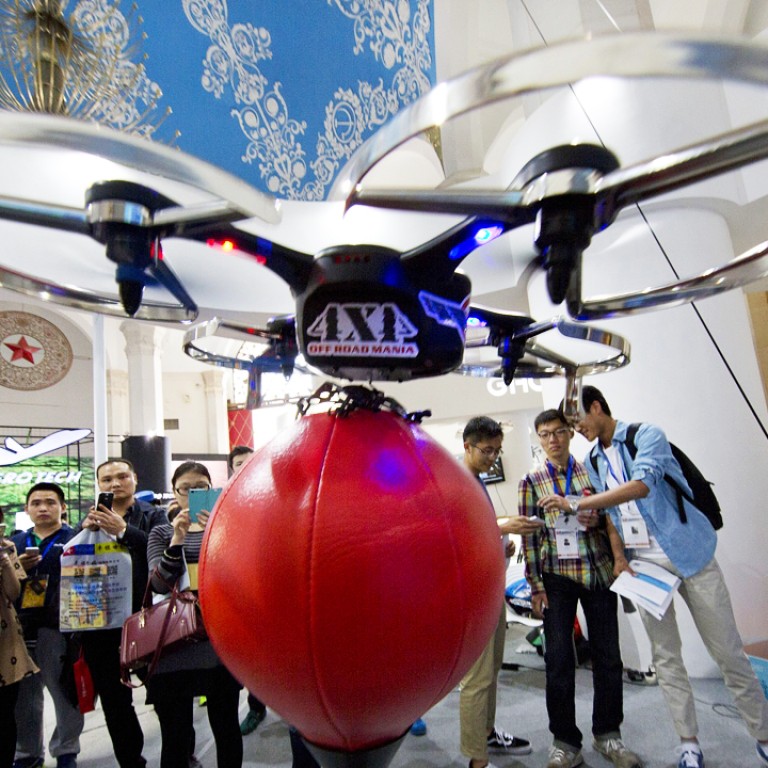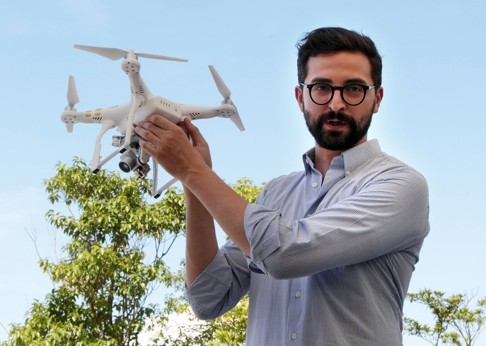
Drone maker DJI plagued by copy cats as price war begins in China’s Shenzhen among makers of hot aerial photography tools
More players are rushing into the market for civilian drones and offering products with similar specs as current market leaders for half the price or less courtesy of cheap manufacturing plants in the Chinese city of Shenzhen, where many of the world’s drone companies are based.
Hundreds of start-ups focused on drones or spin-off industries are located in this former boomtown in Guangdong province opposite Hong Kong including China’s DJI, which now makes up over 70 per cent of the global market for commercial drones.
But many say they have been feeling the pinch for several months as more manufacturers jump into the fray, which has triggered a price war that can only benefit China’s growing army of photography hobbyists - who often start with a smartphone, then buy a selfie stick and later move on to a drone.
The US-based Consumer Electronics Association forecasts the global market for consumer drones will approach US$300 million by 2018.
Scores of companies have been inspired to join this burgeoning industry by the success of DJI, now the world’s biggest maker of consumer and small commercial drones with a market valuation of about US$10 billion.
According to Zhang Jie, CEO of GUAV intelligent technologies company, about 80 per cent of the industry is now concentrated in this teeming industrial Chinese city.
South Holdings sells drones to retailers at US$250 a unit including a camera mount, remote control and high-definition screen. A similar product from DJI costs at least US$700.
“Our advantage is that we are cheaper”, said Neo Yu, a sales manager at the Chinese company.
DJI’s Phantom series have become a classic design for drones, much like the iPad for tablets.
Many new players adapt its design to their products. At least four suppliers at this week’s Global Sources mobile electronic show in Hong Kong demonstrated products that looked like they had borrowed from DJI in terms of design or functionality.
“When people think about drones, they think about the Phantom,” said Yu.
“If we provide a new design, the market may not welcome it.”
Plagiarism is another problem, especially in a country and city known for its lax regulation of intellectual property rights.

“Our boss saw [a Phantom] at a local cafe and decided to base our drone on a similar design,” said Zhang Fuyuan, a sales engineer for Apex Toys, also based in Shenzhen. The company’s Falcon looks almost identical to the Phantom.
“When we were designing our drone last year, we never thought the Phantom would become as popular as it has,” Zhang said. The Falcon sells for US$315 at domestic retailers.
For upstart companies looking to make a quick splash in the market, emulating a successful forerunner’s products or designs is standard practice in some industrial circles in China.
Shanghai-based Nine eagles has 18 years’ experience in making remote-control model planes. It started developing drones in March and released two models this month.
“We don’t think we are copying DJI. There is a lot of original design in our products,” marketing manager Jason Zhang.
The company’s Mola Tourist 1 has a body similar to French brand Parrots’ popular Bebop Drone, while its landing gear is similar to DJI’s high-end Inspire 1.
But the Tourist 1 has a sonar sensor at its front and bottom as well as an extendable camera that neither of the other two models possess.
Zhang said the company’s next product will feature a complete redesign.
“We have short-term plans as well as a long-term strategy for us as a company,” he said.
Drone manufacturing is a very lucrative industry, according to another sales manager of a Shenzhen-based drone technologies company.
“Our profit margin is about 40 per cent or 50 per cent,” he said on request of anonymity.
South Holding is an OEM company that also produces laptops and tablets for international brands like Intel and Microsoft.
“We earn about two US dollars for each tablet,” said Neo.
“But we make a profit of 50 US dollars per drone.”
Despite this, the company said it won’t transform itself into a full-time drone producer,
“The OEM business is big and established and it bring in a steady profit,” Yu said.
“But the drone market will always be limited as not everybody needs aerial photography.”
However, Nine eagles is hiring aerial engineers as it transforms from a model aircraft maker into one specialising in drones.
Chinese drone makers also make more money in international markets than at home, they say.
The wholesale price for Apex’ Falcon is US$ 415 for international buyers but only US$ 315 for buyers in China.
“There are more enthusiasts out there who are wiling to pay higher prices,” said Zhang Fuyuan, Apex’s sales engineer.
“Chinese manufacturers tend to lower their domestic prices as the competition at home is too fierce.”
The high-end drone market dominated by DJI is attracting competition as well.
ZeroTech, a Shenzhen-based maker of the Xplorer quadcopter series, sells its Xplorer at between 2,499 yuan and 3,999 yuan, taking on DJI’s Phantom 3 that costs at least 4,799 yuan.


